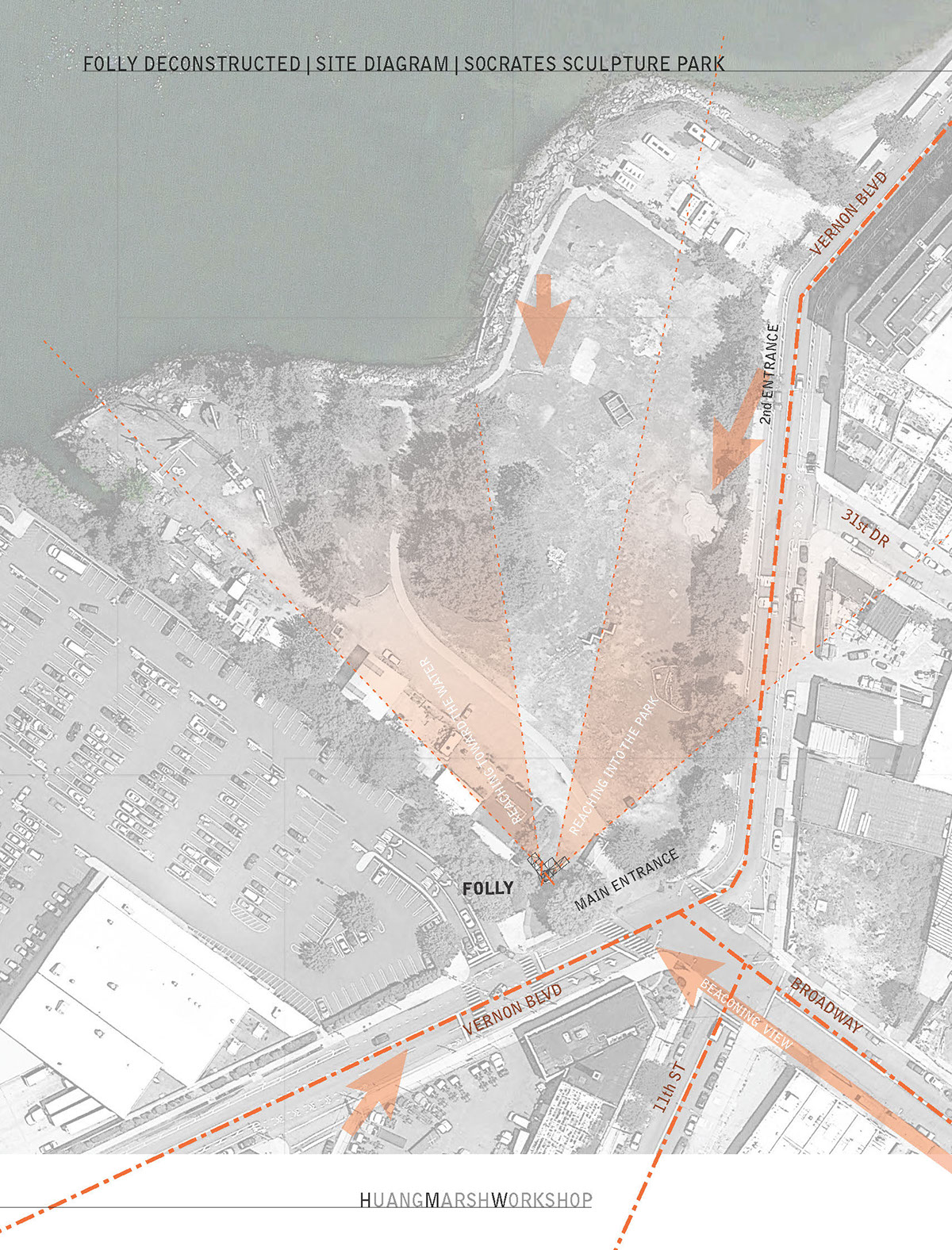HUANGMARSHWORKSHOP proposes to reinterpret the iconic image of the folly. The form and concept of the stone tower set into the landscape is deconstructed, twisted, and stretched. Its solid walls become translucent and reflective, rendered in agricultural shade fabrics and metal. The resultant form will be a beacon from the corner, attracting visitors to the park and guiding them towards its reaches. This contemporary, lightweight, tower will be an intense aesthetic experience that changes as one moves around and within the structure. The shimmering interior will frame views toward the sky and into the park, while inviting exploration and wonder – an innovative interpretation of the amazing ruined towers that dot the pastoral landscapes of the European countryside.
Folly – a costly ornamental building with no practical purpose, especially a tower or mock-Gothic ruin built in a large garden or park. -Oxford Dictionary-
The architectural folly functions as a point of intrigue and curiosity that leads one to visually and, in turn, physically traverse and explore the landscape. Follies often punctuate large open expanses with peaked verticality. They are often left partially constructed or in ruin, to evoke a romantic feeling that suggests the passage of time. The folly at Socrates Sculpture Park should be a beacon in the larger urban landscape of Queens. Its position at the corner of the park, near the entrance, is perfect to lure visitors from the street and direct them into the reaches of the park to explore and discover the many sculptures, follies, and moments of interest that make up Socrates Sculpture Park and its collection.
The most iconic and enduring image of the folly is of a tower set in a rolling grassy landscape. We propose to manipulate and render this iconic image in modern materials of industry and agriculture. Taking the iconic form of the tower as a starting point, the conical geometry is twisted, sliced, and partially unraveled to create an open, inhabitable, form that peaks curiosity and invites exploration. The solid mass of the tower is split open and rendered in a two-sided combination of agricultural shade fabrics. The inside is made of aluminet, a reflective metallic fabric that splinters and refracts light from the sun during the day and interior spotlights at night. The outer layer is a slightly more dense weave of white shade fabric that will stand out against the grays and greens of the surrounding hardscapes and vegetation. These twisting strips of fabric are pulled around a tensile cable pyramid that stretches from the top of an eighteen-foot metal scaffolding structure. The scaffolding structure is reminiscent of the scaffolds erected around ancient ruins to preserve them from further structural failure. The sliced and unraveled form, along with the partial transparency of the shade fabric, creates an ethereal presence in contrast to the solidity of the iconic folly that was its inspiration.
The folly acts on several different scales. From a distance, it functions as a beacon, exciting curiosity to lure visitors into the landscape. At close range, the folly provides a spatial and aesthetic experience that is evocative and extraordinary. The height and glimmering aluminet will be a beacon from the street to attract visitors to the park, and the unraveled ends of the fabric strips stretch into the landscape and point visitors toward the park’s extremities or lure them into the folly’s twisting ephemeral interior. Moving around and through the folly will frame irregular and varied views out toward the park, and up to the sky.
The scaffolding super-structure will be made from galvanized steel pipes and secured at the corners with kee klamps. The cable will be attached to the scaffold and stakes in the ground with crimped cable sleeves, and put into tension with a turnbuckle. The fabric strips will be made of 40% aluminet and 50% white shade fabric sewn together with nylon thread and secured to the cables and scaffolding with tension and cable ties. Together, this assembly will be structurally sound and secure while maintaining a light and tensile feeling. It will be an industrial scaffold that hosts the irregular snaking form of the fabric strips.
When the folly is ready to be dismantled, its materials can be reused for their intended purpose – to create shelters that prolong the growing season for urban agriculturalists. The scaffolding bays, when tipped on their sides, will be the perfect size to create a few low fabric tents that will be donated to small agricultural operations around the city. The fabric strips will be sewn together to create the enclosure and allow people to grow hearty vegetables like kale, broccoli, and collard greens well into the winter season.
This folly design puts a contemporary and relevant spin on the iconic romantic folly. It will maintain the function of the beacon in the landscape, and the romantic mystique of the deconstructed form. It will lure people into Socrates Sculpture Park and invite them to explore its rich, shimmering, interior, before directing them toward the water and the further reaches of the park. The contemporary materials of scaffolding, cable, and shade fabric are lightweight and relatively easy to construct and dismantle, and their repurpose is tied to the health and sustainability of the city and its inhabitants. The iconic stone tower in the landscape becomes an ephemeral construction that twists from the sky to the ground and stretches into the surreal landscape of Socrates Sculpture Park.







